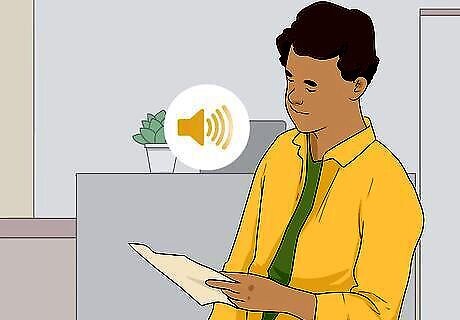
views
Working on Vocal Delivery

Do verbal exercises to warm up your voice. Shake any tension in your arms and legs loose, roll your neck in circles, and scrunch up your face and release it. You can also loosen your jaw by yawning as widely as you can. Then, say each vowel sound and draw them out to relax your throat (for example, a becomes aaaaahhhhhh). Go through the consonants next, focusing on any that you struggle with. Finally, say a few tongue twisters, such as "Theophilus Thistler, the thistle sifter, in sifting a sieve of unsifted thistles, thrust three thousand thistles through the thick of his thumb." Breathe slowly, in through the nose and out through the mouth. Spend at least 5 minutes practicing exercises before you read, and set aside 10-15 minutes if you are preparing for an audition or job.

Enunciate each word carefully. Make sure that you pronounce each word fully and correctly. This can help you speak a little more slowly and your voice will sound clear. This can also help reduce the sound of some accents. For example, if you tend to drop the end of -ing words, slow down and make sure you say the whole word (fishin' vs. fishing).

Slow down your pace. In day-to-day situations, you might speak more quickly than you realize. For news reporting, you will need to slow down the pace you speak at and carefully enunciate each word. However, if you speak too slowly, viewers might lose interest. Listen carefully to news reports and try to match the pace. Most reporters aim for a pace of around 150-170 words per minute. If you are nervous, you might find yourself speaking faster. Try taking a few deep breaths or meditating for a few minutes before a job if you are nervous.

Use a neutral accent. While there is no rule saying you can't have a strong accent as a reporter, most networks prefer their newscasters to speak with a neutral accent. Try repeating something the reporter says using the same accent and tone. If you have a regional accent, this can help you start to figure out how to move your mouth to sound more neutral. If you have a strong accent, it can take some time to learn how to speak differently. Keep practicing by imitating how reporters sound.

Try for an energetic tone. It can be hard to strike the right balance of sounding upbeat without sounding hyper. A good rule of thumb is to pretend you're telling the news to a friend. You are probably excited to tell your friends news, but you try not to overwhelm them with too much energy. The goal is to sound upbeat and friendly, not like you had too much coffee before you started reading.

Avoid slang and colloquialisms. Stick with the script the way it is written. It will probably sound more formal than you are used to sounding in your everyday conversation, but this is the tone people expect when they tune into the news. When you add comments after you report on a story, stick to the same tone. Using slang makes you sound less reliable. Stick to formal language.

Stay away from filler words. Words like "um," "like," and "uh" are common in everyday speech but they make reporters sound less confident. If you catch yourself about to use a filler word, take a pause instead. This can be difficult at first, but eventually it will become a habit.
Practicing Your Reporting

Watch the news to listen to how reporters sound. Close your eyes to focus on the reporter's voice and inflection. Using their tone, the reporter tells you what is important, what is sad, what is exciting, and what you don't want to miss. It's not so much what they're saying, but how they are saying it. You might notice that the reporter sounds excited, energized, friendly, or confident. Try writing down some words you would use to describe the reporter's voice. You can use these words for reference when you're practicing. Look at the reporter's body language. Watch how the reporter's face reflects the tone of the story. Look at where the reporter places their hands.

Record yourself reading a report to spot your weaknesses. Break out the video camera or smart phone and either record video or audio of yourself. Play it back and listen closely. Watch the news and compare your voice to the reporter's. Try not to criticize yourself too harshly. You are comparing yourself to professional newscasters while you are just getting started. Simply compare to see how you can improve.

Practice keeping your eyes still while reading from a distance. Type up and print a news story that you want to practice reading. Use a font that is 1.5" to 2" tall and in a sans-serif style, such as Arial or Helvetica. This will most accurately reflect the teleprompter type-style. Place the papers on a table across from you and try to read them while moving your eyes as little as possible. You'll often see a reporter with papers in their hand. You practice this way, too. Practice glancing down at your notes and then conveying the story, rather than reading directly from your notes.

Be prepared to go off-script from time to time. This is called ad-libbing, and you might see examples of it between two stories or at the end of a story on the news. A reporter might give a brief opinion or make a comment about the story. Come up with a few phrases you can use for a variety of situations so that they sound natural. For a serious story, you can say something along the lines of, "What a tragic event for the neighborhood," or "Let's hope everyone makes a full recovery." Make it clear that you care about the situation. For a feel good story, you can keep it simple by saying something like, "How fun!" or "That really warms the heart." It's important to stay neutral for political stories. Good examples of comments could include, "This race is really heating up," or "This has been a really exciting story to follow." These comments still give an opinion while remaining neutral.
Reading Naturally

Read through a report silently first. Take in every word of the report, don't just skim it. If you're stumbling over words in your report, you won't sound confident. The more familiar you are with the text, the more confidently you'll be able to read it out loud. If you don't have a specific report you're reading, try taking a story from a newspaper or looking up sample stories online.

Look up any words you don't know. This will help you with understanding the context of what you're reading. It will also help you pronounce any unknown words correctly. The more words you know, the better you will be able to make an educated guess about unknown words you come across in a report.

Practice reading out loud while you are alone. To practice reading confidently, find a place where you can read through a news report as many times as you need to for your voice to sound smooth and natural. Don't be afraid to raise your voice. Speak with a loud, strong tone. Try using a mirror to look at yourself while you read. This can help you make sure your facial expressions are confident and match the tone of the story. It will also help you practice to get glance at a report then read it well while looking straight ahead. Once you've built up some confidence, you might want to ask a close friend or family member to listen in and give you feedback.

Adjust your tone based on the content of the story. In general, more somber stories call for a more quiet voice. It can be a fine line to figure out how to speak loudly enough while striking the right tone. Practice speaking more quietly while maintaining your clear tone. For fun stories, try to loosen up a little bit so that you sound more upbeat.

Read out loud frequently in case you need to do a cold reading. The more you practice reading out loud, the more prepared you will be in case you need to report on a story without seeing it ahead of time. If you do need to do a cold reading, keep calm and take your time as you read through the story. Try to maintain eye contact as much as possible, but you can glance at your notes or the teleprompter more than you usually would. This is especially important for breaking stories. You might get bullet points ahead of time, but you will probably see the story for the first time as you are reading it.
Using Body Language

Sit up straight with your head up and your shoulders back. Don't slouch. Project confidence with your body language. If you are planning to be professional reporter, you may need to maintain this posture for several hours at a time, so build up your strength by practicing good posture throughout the day. For serious reports, it's especially important that your body language reflects the tone of the story. If need be, pause and check your posture and facial expression before a serious story.

Use hand gestures to add meaning to your report. It's important to make sure that your hand gestures look natural and add meaning to your words. Think about what hand gestures you may want to use in advance, but don't script them out, otherwise they will look robotic. If you don't normally use your hands to talk, start slowly. Try using one or two hand gestures in a report. If you try to add many more, it may look unnatural.

Make eye contact with the camera as much as possible. To make it seem like you are connecting with the audience and simply telling them the news, avoid making it look like you are reading off of a card or teleprompter. Try to skim over the words you are reading as quickly as possible so that you can make eye contact with the camera. If you are co-reporting, it's natural to break eye contact to look at your colleague every once in a while, especially if you are speaking to each other.

Use natural facial expressions. It's important not to seem to stiff while you are reporting. Using your facial expressions to reflect the tone of the story can make you seem more relatable and human while you are speaking. Make sure your facial expressions are appropriate for the story. Although a warm, friendly smile is generally appropriate, make sure to use a more serious expression when reporting on something like a death or accident.

Project confidence with your body language. You will naturally give off confidence with a combination of your tone of voice, your posture, and your body language. After you've practiced and prepared as much as you can, relax. Focus on doing your best. Having confidence in yourself will give off confidence in front of the camera. To be more convincing, you should have eye contact and a strong body posture. Besides this, pause and have certainty in your speech. Be clear and concise.




















Comments
0 comment